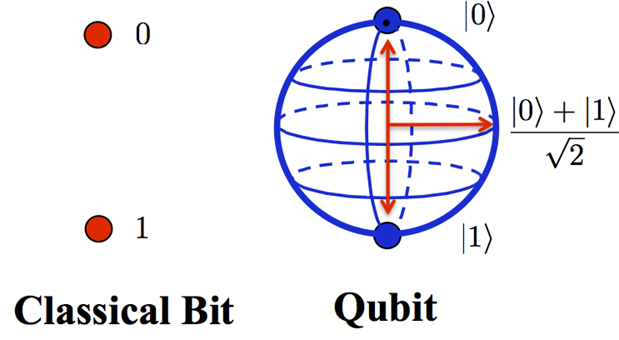Quantum Entanglement: An overview
Imagine if we have some technology which can transfer the signals faster than the speed of light. Amazing right! It can really be lifesaving technology for us. Suppose if we placed this device near to the blackhole at the centre of our milky way galaxy. If the blackhole disappears or explodes for some reason, we will get this notification at the same instant; for the same light will take several thousand years to reach us. This means we will get an extra thousands of years to tackle this problem when the actual effect reaches us.
Do we have any such technology? If yes, then how this works and how it will benefit us?
Today we use a communication system using electromagnetic waves. This existing technology will not give communication faster than the speed of light as it itself uses light. So, what other options do we have?
Quantum Entanglement:
To go further let’s come back to time. In the 20th century Einstein proposed a thought experiment where, according to the theory, an event at one point in the universe could instantaneously affect another event arbitrarily far away.
In order to understand it, first understand spin. All fundamental particles have a property called spin. They have angular momentum and have an orientation in space. Now, upon measuring this spin we can get only one of two outcomes. Which is “Spin up” when a particle's spin is aligned with the direction of measurement or, “Spin Down” when it is opposite the measurement.
Now in a system of two particles, the total angular momentum of the system must stay constant i.e., if one particle is measured to have spin up, the other, measured in the same direction, must have spin down.
To note that, it’s only if the two particles are measured in the same direction that their spins must be opposite.
According to quantum mechanics, these particles don't have a well-defined spin at all. They are entangled, which means their spin is simply opposite that of the other particle. So, when one particle is measured, and its spin determined, you immediately know what the same measurement of the other particle will be. This fact has been proved by many authorities. It doesn't matter at which angle the detectors are set, or how far apart they are, they always measure opposite spins.
Now just look how interesting it is. Let both particles have undefined spins, and then you measure one, and immediately you know the spin of the other particle, which could be light-years away. It's as though the choice of the first measurement has influenced the result of the second faster than the speed of light, which is, indeed, how some theorists interpret the result.
To add, where is this theory being used?
Quantum teleportation:
In 2017, a group of Chinese scientists successfully completed a test of quantum teleportation, by teleporting a photon from earth to a satellite. Teleportation is a big part of science fiction, and many people are curious about it. This teleportation shown in sci-fi movies is dematerialising an object at one place and materialising it at the destination.
Getting close to achieve the teleportation technology is still a far away dream because quantum teleportation is different, which means transferring information without any medium. Basically, in quantum mechanics every particle has different quantum values making it unique, so no two particles can be same and if we use this fact along with the theorem of ‘no cloning and deleting’ of teleportation, we can achieve quantum teleportation.
In quantum teleportation not the object but its quantum information is shared without any medium.
We share one qubit by sharing two classical bits. We know now that quantum entanglement is a connection between two particles that affects one on the action of another.
Basically, the two particles are referred as a single object with a single wave function for the sake of mechanics. So, it is an object with distance between two parts that have the same wave function. But for the sake of explaining let’s assume two particles with a quantum entanglement i.e., single wave function. So, what if we transmit the quantum information using one particle and receive at the other, we could make the particle at other destination and thus attain teleportation.
(Refer the picture on right).
Now, it is possible for Beta to make a photon with the received information by manipulation, but Beta is still unaware that the information of photon C has been received.
Here we are required to use traditional methods of communication between Alpha and Beta to convey this message. So, photon B has the quantum information of photon C and by manipulating it we can create a perfect clone for C. After this the entanglement breaks with B having quantum states of C, so we could say that we teleported quantum C from Alpha to Beta.
But Alpha still has A and C photons, so how do we say we teleported photon C?
By ‘no cloning and deleting’ principle, as soon as Beta manipulates clone of C and extracts the quantum states, the state of original photon C changes into a different and unique form because no two particles have the same quantum states, this photon changes and has different properties. So, Alpha no longer has the same photon C, but Beta does. TELEPORTATION!!
which will take the computing power to a whole new level.
Superdense Coding:
Let’s consider the above example of Alpha and Beta, but here Alpha must transmit information worth 2 classical bits. Alpha now has 4 choices of quantum gate operations to chose from to perform on his share of the entangled pair. Here, Alpha and Beta sharing a pair of quantum entangled particles is must. The sharing of two bits by one qubit is impossible without this requirement. Alpha will choose what operation to apply based on what bits he must transfer. Then the qubit state evolved from the chosen gate is sent to Beta, this qubit has information of the 2 bits Alpha performed the operation upon.
Alpha can send the entangled qubit to Beta using a quantum network through some conventional physical medium. This information is now accessible to Beta because of their pre-shared entangled pair. After operating and measuring on the pair, the enclosed information is now accessible to Beta. So, Beta has two classical bits of information. Superdense coding is the basic idea behind secure quantum secret coding. The necessity of having both qubits to decode the information being sent eliminates the risk of eavesdroppers intercepting messages. This security is utmost important and will also be useful in quantum internet. Even if the information is intercepted and measured the entanglement breaks and the parties involved become aware of the situation.
This is the reason why financial data and important codes use quantum technology and qubits to transfer.
Ultra-precise clocks:
This precision depends on how many atoms are squeezed and kept in vacuum for the clock. The number of atoms is directly proportional to precision, but there is a limit. Scientists have taken up this challenge of increasing the limit of precision by using quantum entangled particles. Entangled atoms would not be preoccupied with local differences and would instead solely measure the passage of time, effectively bringing them together as a single pendulum. This is going to be a very big aspect; it will enhance precision of atomic clocks by ten times. Entangled clocks could even be linked to form a worldwide network that would measure time independent of location.
There are many applications of quantum entanglement besides the ones mentioned above, such as: Super computing power, improved microscopes, biological compasses, etc. We have tried to explain so that we could move to the next big question: Communication faster than the speed of light, possible or not?
Conclusion:
(i.e., answer to question that whether we can use quantum entanglement to communicate faster than speed of light)
There is debate over how to interpret results mentioned above. Some physicists see them as evidence that there is no hidden information in quantum particles, and it only makes sense to talk about spins once they've been measured, whereas other physicists believe that entangled particles can signal each other faster than light to update their hidden information when one is measured. So, does this mean that we can use entangled particles to communicate faster than light?
Well, everyone agrees that we can't. And that is because the results that you find at either detector are random. It doesn't matter which measurement direction you select, or what's happening at the other detector, there's a 50/50 probability of obtaining spin up or spin down.
Only if these observers later met up and compared notebooks, would they realize that when they selected the same direction, they always got opposite spins. Both sets of data would be random, just the opposite random from the other observer. So, classical means of communication are still necessary and this rules out our question. That is, indeed, spooky, but it does not allow for the communication, the sending of information from one point to another, faster than light, so it doesn't violate the theory of relativity.
Credits and References:
Prathviraj Chavan (Mechanical): Team Tech Tuesday
Vijaysingh Rajput (Mechanical): Team Tech Tuesday
https://www.youtube.com/watch?v=uLfHssrNxUk&t=544s
https://www.youtube.com/watch?v=unb_yoj1Usk
https://en.wikipedia.org/wiki/Quantum_entanglement
https://quantumxc.com/blog/is-quantum-communication-faster-than-the-speed-of-light/
This blog is meant for Educational purposes only. We do not own any Copyrights related to images and information; all the rights go to their respective owners. The sole purpose of this blog is to Educate, Inspire, Empower, and create awareness in the viewers. The usage is non-commercial(Not For Profit), and we do not make any money from it.
FOLLOW US ON:-
INSTAGRAM :
https://bit.ly/coep_blogs_insta
LINKEDIN:
https://bit.ly/coep_blogs_linkedIn
YOUTUBE:-
https://bit.ly/Coep_blogs_YouTube











Comments
Post a Comment